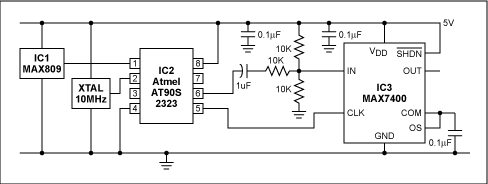A similar version of this article appeared in the May 15, 2003 issue of EDN magazine.
The circuit of Figure 1 produces an accurate variable-frequency sine wave for use as a general-purpose reference signal. It includes an 8th-order elliptic, switched-capacitor lowpass filter (IC3) that is clocked with a 100kHz square wave generated by microcontroller IC2. (Any other convenient squarewave source is also acceptable.) The microcontroller is clocked by a 10MHz oscillator module. A voltage supervisor (IC1) ensures correct operation in the event of a power failure. IC3 sets the filter's cutoff frequency at 1/100 the clock frequency.

Figure 1. By removing harmonics from a square wave, this circuit generates an accurate and adjustable sine-wave output
The 8th-order elliptic filter's sharp rolloff sharply reduces the harmonic amplitudes in a 1kHz square-wave input, thereby producing a near-perfect 1kHz sine wave at its output. Using divider-chain logic or a processor, you can then create a digitally adjustable sine-wave source by adjusting the clock and input frequencies while maintaining a ratio of 100:1 between them.
To prevent clipping at the positive and negative peaks, attenuate the input signal and superimpose it on a dc level of VCC/2. The result (for a 5V input) is a 2.25V peak-to-peak output.
Related to this Article
Products
3-Pin Microprocessor Reset Circuits
8th-Order, Lowpass, Elliptic, Switched-Capacitor Filters
{{modalTitle}}
{{modalDescription}}
{{dropdownTitle}}
- {{defaultSelectedText}} {{#each projectNames}}
- {{name}} {{/each}} {{#if newProjectText}}
-
{{newProjectText}}
{{/if}}
{{newProjectTitle}}
{{projectNameErrorText}}
